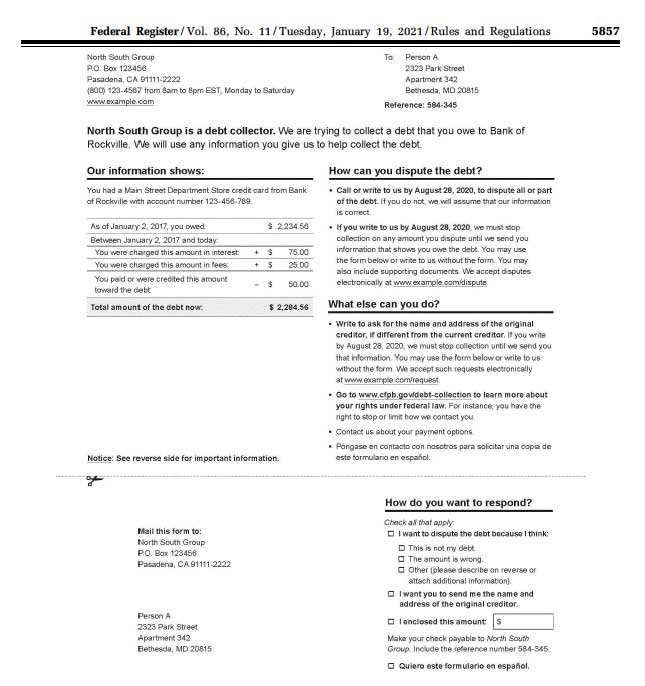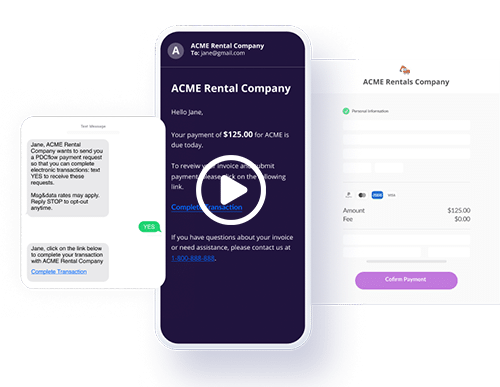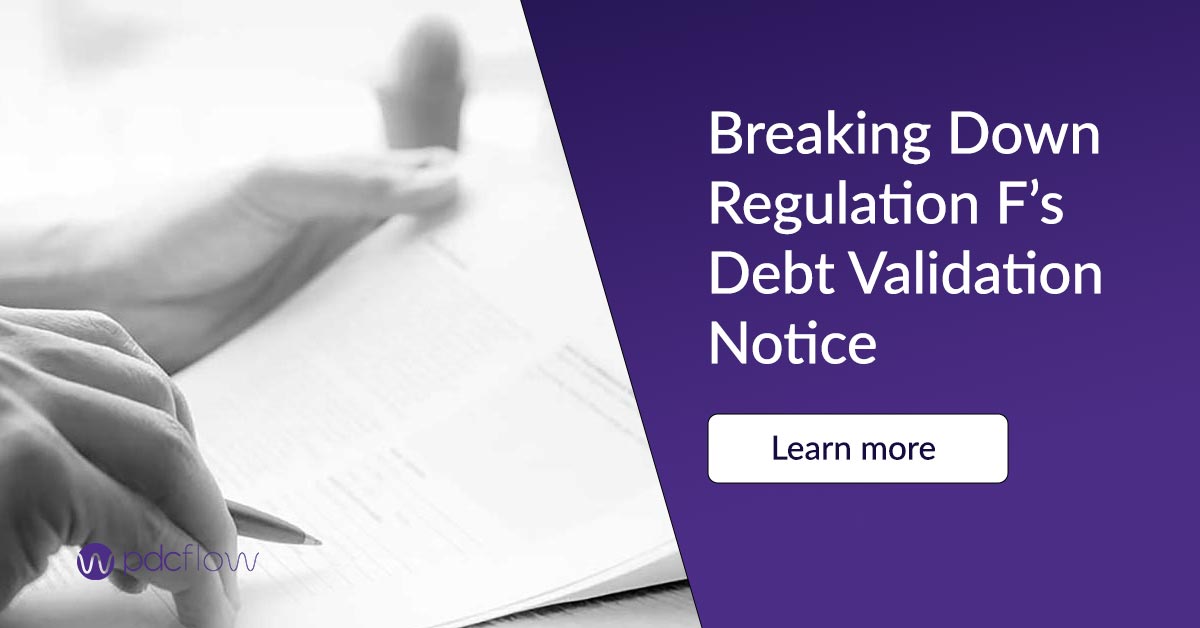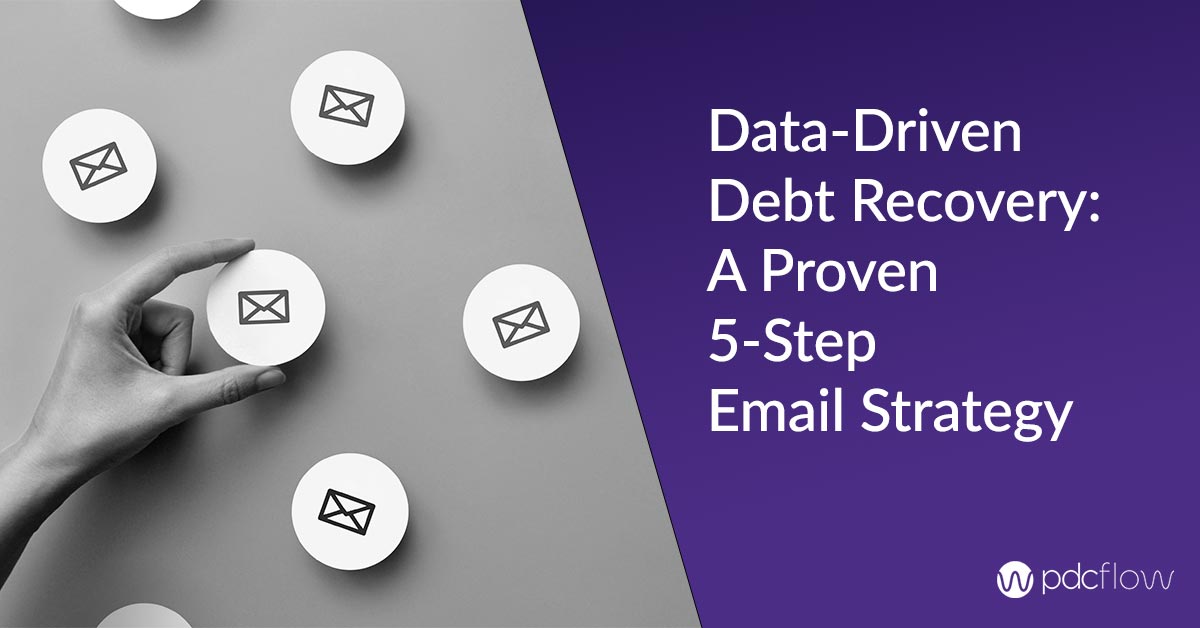If your debt collection agency doesn’t use email to talk to consumers, you’re never going to reach your full recovery potential. Phone calls are less effective than ever in making consumer contacts and traditional mail can be costly.
Sending the model validation notice by email:
- Encourages more consumer engagement
- Is a compliant option
- Saves money
- Is faster than mail
Still, implementing model validation notice emails requires planning. Here are the three main concerns agencies have raised, and what you need to know to start sending compliant notices by email.
1) Consent
Passthrough consent
Passthrough consent means using email addresses that the original creditor collected. It is fine to use these addresses to send the model validation notice – as long as it’s the first communication with consumers.
If the consumer has already been contacted, you can not rely on passthrough consent. Agencies should scrub these email lists before starting to send model validation notices.
E-Sign Act consent
Not every agency wants to or has the option to send a consumer the model validation notice email as their first communication.
If an agency contacts the consumer through another channel but still wants to email the model validation notice, they must get further consent in accordance with the E-Sign Act before emailing.
The E-Sign Act says consumers must opt in to receiving electronic records. If you obtain this consent during your interactions in other channels, you can still send the model form through email.
2) Deliverability
One of the biggest perks of email is that it makes customer communication faster and easier. That’s only true if emails end up in the inbox. Agencies should partner with a company that does all they can to ensure email deliverability.
For example, PDCflow monitors our complaint rate so we know when emails are being marked spam and can make adjustments as needed. Email addresses that have bounced in the past will also be blocked from receiving new messages until an employee manually updates information.
What counts as a delivered email?
One of Regulation F’s debt validation notice requirements is to make sure the notices you send actually make it to your consumers.
For a mailed validation notice, you can’t tell for certain if a debt collection letter makes it to your consumer but if it isn’t returned, it’s considered sent.
Email isn’t much different. If you send an email and it bounces, that message has not been delivered. Agencies need a backup plan to send the model validation notice another way for these bounced contacts.
3) Content
Of course, one of the biggest concerns about emailing the model validation notice comes from deciding how your email will look and what it will contain.
To be eligible for safe harbor rules, debt collection agencies must send an email that is substantially similar to the sample provided in the FDCPA's Regulation F. This means:
The format of the email should look as similar to the original as possible. Keep elements in the same order. Do not shift lower sections higher up in the email.
Don’t hide the content of the model validation email behind a link that requires a password to access.
For the easiest accessibility, agencies should try to provide the entire text of the notice within the body of the email. If this isn’t possible, you may provide the information as a downloadable PDF.
While a PDF is a compliant solution for sending the model validation notice, this may hurt consumer engagement. If people don’t recognize your company name, or are concerned about scam emails, they may not trust you enough to click on any attachment you send.
Sample Model Validation Notice

Other Ways to Use Email for Debt Collection
Payment authorizations
Regulation E says a payment authorization is required before you take recurring payments. Beyond this, payment authorizations can protect your agency against chargebacks.
Sending these requests to an email address while the consumer is on the phone is the best way to fulfill compliance and start taking payments faster.
Payment reminders
Payment reminders encourage customers to reach out proactively before something goes wrong with a payment.
There are many times someone will need to make a change – the transaction date, how much they can pay, or a different payment method. Email reminders give consumers an easy way to stay on top of their payments.
PDCflow’s software makes it easy to send email reminders to consumers. These can even include a link to a payment page, so people can pay right away directly from their reminder message.
Payment requests
Digital payments help companies bring in revenue faster by making it simple for consumers to pay.
Not everyone is available to call in and make a payment during business hours – and others don’t want to, so self-serve options are important. However, other customers want to speak to a representative before they pay.
Payment request emails are good both for people who don’t like phone calls and for those who need to talk to an agent before paying. With PDCflow, companies can offer both.
- Send payment requests to an email or mobile number. The recipient can go directly to a payment portal and make their payment without ever needing to talk to a collection agent.
- Or, staff can send an email or text message to the consumer while on the phone discussing the bill. Consumers get to enter their own payment information to keep it safe and agents can make sure the payment was applied.
Document delivery
Emails are good for customer service interactions. Sometimes, consumers may want an invoice sent to them, or may request a paid-in-full or other important notice.
Email makes it possible to deliver those documents while an agent is still on the phone, so everyone can review them together. If there are questions on a bill, an agent can answer them. If you need a signature, the employee can make sure the workflow gets finished.
Speeding up these types of consumer interactions resolves issues, so you can close accounts faster, with fewer contacts.
PDCflow’s software lets you send documents to consumers, with or without a request for an esignature.
Message tracking
Automated notifications keep individuals or teams current on what is happening with a consumer’s workflow. Was their payment request opened? Did they sign the document you needed them to sign?
Using email and SMS to communicate with consumers makes it easier for your agency to monitor these stages and follow up when needed.
PDCflow offers event notifications, so individuals or teams can stay informed and make sure consumers are completing the requests you send.
Better Results With SMS and Email Together
Sometimes, the best results in debt collection come from offering more choice and letting consumers decide for themselves how they want you to contact them. This means offering more than just email. SMS and email together can be more effective because they offer:
- More choice for consumers - Not everyone wants to opt into email. If you have both email and SMS, you can offer even more options for consumers, which increases the chances of successful contacts. This makes it easier to close accounts.
- Different channels for different campaigns - There are times when sending a text message will be more effective than an email to engage consumers. For instance, certain SMS payment campaigns may be more likely to see higher open rates than email. This means more people will engage and pay.
- Many channels for better engagement - An effective strategy for better collection results is to combine different channels for one campaign. For example, sending an email, then following up with an SMS may give people the nudge they need to take action.
PDCflow for Email, SMS, and Payments
Email and SMS
PDCflow lets customers send text and email to consumers for a variety of purposes:
- Document delivery - PDCflow lets companies send documents through email or SMS, so customers can access statements, settlement offers, or other important paperwork without having to wait for the mail.
- Digital Signatures - your agency will need to gather payment authorizations, settlement agreements, or other signatures from consumers. Use PDCflow email and SMS to send requests, so you can capture a legally binding digital signature in a matter of minutes.
- Payments - use email or text messages to request payments. These can include other actions as well (document delivery, signature request, photo upload request). This way, customers can make payments securely directly from their inbox or mobile device.
Payment Options and Channels
PDCflow offers credit card and ACH processing as well as cash tracking, so consumers can pay the way they prefer. We also provide a number of payment channels so collection agencies can offer more choices to consumers.
- White labeled online payment portals
- Email and text payment request links
- QR codes on printed statements to lead directly to a payment page
- Employee-initiated payments
Personalized Bulk Messages
Personalized bulk messages let your agency send thousands of communications and payment requests at once through a simple CSV file upload.
This saves time when sending one-time messages for single campaigns, or other instances when you need to send updated terms of service or other documents to a large number of clientele.
Integration options
Collection agencies can use PDCflow through our application, one of our integration partnerships, or through open APIs to integrate features directly into your current system of record.
For those who want even more SMS capabilities, we offer white-labeled texting service APIs. This is great for companies who want to text, but don’t have time or resources to go through the 10 Digit Long Code (10DLC) registration process phone companies require.
PDCflow facilitates 10DLC and message registration, so collection agencies don’t need to go through the process alone.
After registration, companies can customize messages for better engagement, track messages, and easily manage opt-ins and opt-outs.
For more information on PDCflow’s email and SMS communications and payment options, meet with a Digital Communications Expert today.






